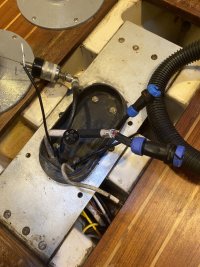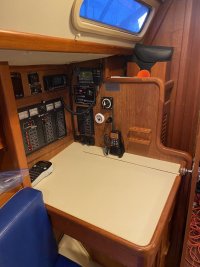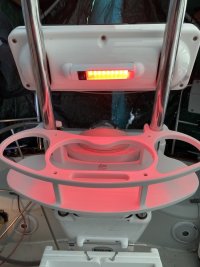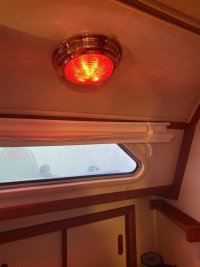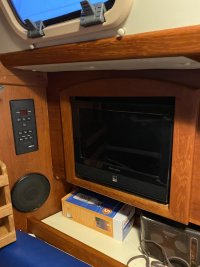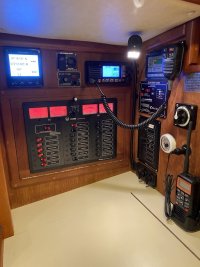Since purchasing my 1996 Pacific Seacraft Ericson 380 back in October I've been busy working through my to-do list. The following have been some jobs on the electrical side I've been working on that could be useful for other Ericson owners.
The first surprise was when we went to unstep the mast for winter storage only the mast lights and VHF radio had disconnect plugs inside the access panel at the foot of the mast. I had to cut the radar cable and wind instrument cables inside the mast! I'm guessing that these items were installed on the boat with the mast up and the boat has never had the mast unstepped in over a decade. So one electrical project has been installing disconnect plugs at the foot of the mast and at the mast step using aircraft grade disconnect plug/sockets. It's very tedious soldering the connections but I know from experience it's well worth it if you have to unstep the mast for winter storage each year. Picture is of half completed job as I'm still waiting on the 6 pin connector for the wind instrument (supply chain delays etc.) and I've yet to add DYMO flag labels for each cable. The plugs are supposedly aircraft grade and available from eBay etc.
Next project has been installing nav desk nav light, 12V outlets for charging items at the nav desk, in the forward and aft cabin, on the cockpit pedestal, and for the TV/TV antenna amplifier, new MPPT PV controller with isolation switch and wiring to batteries and to stern ready for solar panels in the spring. Also installed a high bilge alarm with external alarm in the cockpit. I changed the instrument lamps behind the AC and DC meters that had burnt out, the panel looks cool now glowing red. I was short of real estate at the nav station and decided to move the hour meter and fuel tank gauge back to the cockpit engine control panel. It was odd as to check the fuel tank I needed to go to the cockpit and put the key in to the start position then head back to the nav station to check the gauge. The remaining gauge at the Nav station is the head tank monitoring gauge. With all the changes I've had to carefully install new items to fill the holes.
I've been changing all the lights to LED and in the head I've gone with a white/red combo dome light. These are a great for leaving on at night so you and your guests can find and use the head without having to turn on the normal white lights and wake everyone else up onboard. I've also got a small strip white/red LED lamp on the rear of the navpod that is great at night for light in the cockpit. The boat use to have an old CRT TV that had been installed in a modified locker, luckily I had a 12V combo DVD/TV from my old boat that was a perfect size for the hole and is on swivel arm so it can be pulled out for viewing and DVD storage behind it etc.
My next blog I'll go over the update to the electronics installing the new VHF radio, i70s multifunction displays, and networking it all via SeaTalk NG (NMEA 2000).
The first surprise was when we went to unstep the mast for winter storage only the mast lights and VHF radio had disconnect plugs inside the access panel at the foot of the mast. I had to cut the radar cable and wind instrument cables inside the mast! I'm guessing that these items were installed on the boat with the mast up and the boat has never had the mast unstepped in over a decade. So one electrical project has been installing disconnect plugs at the foot of the mast and at the mast step using aircraft grade disconnect plug/sockets. It's very tedious soldering the connections but I know from experience it's well worth it if you have to unstep the mast for winter storage each year. Picture is of half completed job as I'm still waiting on the 6 pin connector for the wind instrument (supply chain delays etc.) and I've yet to add DYMO flag labels for each cable. The plugs are supposedly aircraft grade and available from eBay etc.
Next project has been installing nav desk nav light, 12V outlets for charging items at the nav desk, in the forward and aft cabin, on the cockpit pedestal, and for the TV/TV antenna amplifier, new MPPT PV controller with isolation switch and wiring to batteries and to stern ready for solar panels in the spring. Also installed a high bilge alarm with external alarm in the cockpit. I changed the instrument lamps behind the AC and DC meters that had burnt out, the panel looks cool now glowing red. I was short of real estate at the nav station and decided to move the hour meter and fuel tank gauge back to the cockpit engine control panel. It was odd as to check the fuel tank I needed to go to the cockpit and put the key in to the start position then head back to the nav station to check the gauge. The remaining gauge at the Nav station is the head tank monitoring gauge. With all the changes I've had to carefully install new items to fill the holes.
I've been changing all the lights to LED and in the head I've gone with a white/red combo dome light. These are a great for leaving on at night so you and your guests can find and use the head without having to turn on the normal white lights and wake everyone else up onboard. I've also got a small strip white/red LED lamp on the rear of the navpod that is great at night for light in the cockpit. The boat use to have an old CRT TV that had been installed in a modified locker, luckily I had a 12V combo DVD/TV from my old boat that was a perfect size for the hole and is on swivel arm so it can be pulled out for viewing and DVD storage behind it etc.
My next blog I'll go over the update to the electronics installing the new VHF radio, i70s multifunction displays, and networking it all via SeaTalk NG (NMEA 2000).

